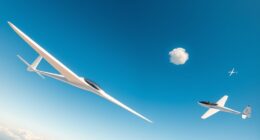I’ve got a secret to share with you, my fellow photography enthusiasts. If you want to take your shots to the next level, you need to master the art of the gliding shot. Trust me, once you’ve nailed this technique, your photos and videos will have a professional and cinematic quality that will leave your audience in awe.
In this article, I’m going to spill all the tips and tricks you need to know to capture the perfect gliding shot. So, grab your gear and get ready to glide like a pro!
Key Takeaways
- Choose equipment that provides stability and flexibility, such as camera stabilizers and wide-angle or telephoto lenses.
- Scout out locations with expansive views and minimal obstructions for the perfect backdrop.
- Properly set up and balance your Glidecam or Steadicam for smooth gliding shots.
- Master the technique of controlled gliding and maintain a steady grip on the handle for professional-looking footage.
Choosing the Right Equipment
When choosing the right equipment for capturing the perfect gliding shot, it’s important to consider factors such as camera stability and lens flexibility. To achieve smooth and stable footage, there are budget options available that can meet your needs.
One such option is a camera stabilizer, also known as a gimbal. These handheld devices provide stability by using motors to counteract any unwanted camera movements. They are lightweight and easy to use, making them ideal for capturing gliding shots.
Another essential accessory is a versatile lens. A wide-angle lens allows you to capture a wider field of view, giving your shots a more immersive feel. On the other hand, a telephoto lens allows you to zoom in on distant subjects, adding depth and detail to your footage.
Finding the Perfect Location
To find the ideal spot for your gliding shot, you’ll want to scout out locations with expansive views and minimal obstructions. Finding hidden gems for capturing that perfect gliding shot can be an exciting adventure. But where do you start? Well, scouting locations is key.
First and foremost, look for areas with expansive views. These locations will provide you with a breathtaking backdrop for your gliding shot. Whether it’s a stunning mountain range or a picturesque coastline, a wide-open view will add depth and beauty to your shot.
Next, minimize obstructions. Look for spots that are free from trees, buildings, or any other objects that could obstruct your view or interfere with the gliding motion. These obstructions can ruin the flow and composition of your shot, so it’s crucial to scout out locations that offer a clear line of sight.
To find these hidden gems, explore different areas and keep an eye out for unique landscapes and interesting features. Visit parks, nature reserves, or even remote areas that are off the beaten path. These are the places where you’re likely to find the perfect location for your gliding shot.
Setting Up Your Glidecam or Steadicam
Setting up your Glidecam or Steadicam can be a bit challenging, but with practice, you’ll get the hang of it. To help you on your journey to capturing the perfect gliding shot, here are some essential tips and tricks to master camera balance and troubleshoot common Glidecam issues:
-
Mastering Camera Balance:
Begin by attaching your camera to the Glidecam or Steadicam using the quick release plate.
Adjust the fore-aft balance by sliding the camera forward or backward on the plate until it is perfectly balanced.
Fine-tune the left-right balance by adjusting the side-to-side position of the camera on the plate. -
Troubleshooting Common Glidecam Issues:
If you experience excessive side-to-side movement, check that the camera is properly balanced and tighten any loose screws.
If you encounter vertical bouncing, ensure that the gimbal is properly aligned and adjust the tension in the springs if necessary.
If you notice shaky footage, make sure you are maintaining a steady grip on the handle and practice smooth movements.
Balancing Your Camera
Achieving proper camera balance is crucial for smooth gliding shots. So, make sure to adjust the fore-aft and left-right balance of your camera on the Glidecam or Steadicam.
Camera stabilization heavily relies on weight distribution. By properly balancing your camera, you ensure that it remains stable and steady during movement, resulting in professional-looking shots.
To achieve proper balance, start by adjusting the fore-aft balance. This refers to the front-to-back distribution of weight. Begin by loosening the fore-aft adjustment knob and moving the camera forward or backward until it remains level when released. Tighten the knob to secure the position.
Next, focus on the left-right balance. Loosen the left-right adjustment knob and adjust the camera until it remains level when released. Tighten the knob to lock it in place.
It’s important to note that the weight distribution may vary depending on the specific camera setup and lens being used. So, experiment with different configurations to find the optimal balance for your equipment.
Now that you have achieved proper camera balance, it’s time to move on to mastering the Glidecam technique. Transitioning smoothly between shots and maintaining stability during movement are essential skills to capture the perfect gliding shot.
Mastering the Glidecam Technique
When it comes to mastering the Glidecam technique, there are three key points to focus on: balancing the Glidecam, achieving smooth camera movements, and practicing controlled gliding.
Balancing the Glidecam is crucial for achieving stable shots and preventing shaky footage.
Smooth camera movements are essential for creating professional-looking videos.
Practicing controlled gliding helps improve your overall control and precision with the Glidecam.
Balancing the Glidecam
To avoid shaky footage, it’s important to properly balance the Glidecam. This is achieved through meticulous attention to detail and regular maintenance.
Here are some key tips for balancing your Glidecam effectively:
-
Glidecam Maintenance:
-
Clean and lubricate the joints regularly to ensure smooth movement.
-
Check for any loose screws or parts that may affect balance.
-
Keep the Glidecam stored in a secure and padded case to prevent damage during transportation.
-
Troubleshooting Common Balancing Issues:
-
Start by adjusting the horizontal balance, ensuring the camera is centered on the Glidecam.
-
Fine-tune the vertical balance by adjusting the telescoping post.
-
Check the side-to-side balance by observing the camera’s level on the Glidecam’s spirit level indicator.
Smooth Camera Movements
For smooth camera movements, make sure you maintain a steady grip on the Glidecam throughout your shot. Camera stabilization is crucial in achieving professional-looking footage. To enhance stability, keep your arms close to your body and use both hands to hold the Glidecam handle firmly. This will minimize any unwanted camera shake or jitter.
When it comes to panning techniques, practice is key. Start by keeping your body stationary and smoothly rotate your torso from the waist to pan the camera. Remember to move at a consistent speed to maintain a fluid motion. Additionally, try to anticipate the movement and smoothly transition from one direction to another.
Practicing Controlled Gliding
In the previous subtopic, we learned about the importance of smooth camera movements. Now, let’s dive into the world of controlled gliding techniques and how they can improve camera stability.
To achieve controlled gliding shots, consider the following techniques:
- Maintaining a steady grip on the camera while moving
- Using a gimbal or stabilizer to minimize shake and vibration
- Practicing precise footwork and body movements to ensure a smooth glide
By implementing these techniques, you can greatly enhance the stability of your camera while gliding and capture stunning, professional-looking shots.
Now that we have covered the importance of controlled gliding and camera stability, let’s move on to the next section where we will explore techniques for controlling speed and movement.
Controlling Speed and Movement
Adjust your body position and lean slightly forward to control your speed and movement while capturing the perfect gliding shot. Speed control is crucial in gliding photography as it allows you to create dynamic and visually appealing shots. By leaning forward, you shift your center of gravity, which helps you increase your speed. To slow down or stop, you can lean back or use your feet as brakes.
Another technique to control your movement is by using your arms. By extending your arms out to the sides, you create resistance, which slows down your glide. On the other hand, pulling your arms closer to your body reduces resistance and increases your speed. It’s important to practice these arm movements to find the perfect balance between speed and stability.
Additionally, shifting your body weight from side to side can also aid in controlling your movement. By shifting your weight towards the side you want to turn, you can initiate a smooth and controlled turn. This technique is especially useful when navigating around obstacles or capturing dynamic shots.
Mastering speed control and movement techniques is essential for capturing the perfect gliding shot. With practice and experimentation, you can achieve the desired speed and movement to create stunning and captivating gliding photographs.
Practicing Smooth Transitions
When it comes to capturing smooth transitions in video footage, mastering camera movement is key. This involves understanding how to smoothly pan, tilt, and track the camera to create seamless shots.
Additionally, utilizing stabilization equipment such as gimbals and tripods can greatly enhance the smoothness and stability of your footage.
Lastly, perfecting timing and pacing is crucial in achieving smooth transitions. This involves knowing when to start and stop camera movements and how to maintain a consistent speed throughout the shot.
Mastering Camera Movement
To capture the perfect gliding shot, it’s important to master camera movement. Proper camera movement can enhance the visual appeal of your footage and create a sense of fluidity.
Here are some key points to consider:
-
Camera Angles:
-
Experiment with different camera angles to add depth and dimension to your shots.
-
Low angles can make subjects appear more powerful, while high angles can evoke vulnerability.
-
Utilize Dutch angles to create a sense of unease or tension in your footage.
-
Creative Techniques:
-
Incorporate panning and tilting movements to follow subjects or capture sweeping landscapes.
-
Try using a dolly or slider to achieve smooth horizontal movements.
-
Employ a crane or jib for elevated shots or to introduce dynamic camera movements.
By mastering camera movement, you can take your footage to the next level and create visually stunning gliding shots.
Now, let’s explore the next section on utilizing stabilization equipment to further enhance your footage.
Utilizing Stabilization Equipment
By using stabilization equipment like a gimbal or a Steadicam, you can achieve smooth and steady shots, adding a professional touch to your footage.
When it comes to choosing the right stabilizer, there are a few factors to consider.
First, think about the weight and size of your camera. Make sure the stabilizer you choose can support the weight and accommodate the size of your camera.
Additionally, consider the type of shots you want to capture. If you’re planning on gliding shots, a gimbal might be the best option as it provides 3-axis stabilization for smooth movements.
Finally, practice is key. To achieve steady gliding shots, make sure to keep your movements slow and smooth, using your body as a shock absorber.
Perfecting Timing and Pacing
Remember, timing and pacing are crucial in creating captivating footage that keeps your audience engaged throughout. To capture action effectively and create cinematic shots, here are some key considerations:
-
Determine the subject’s movement: Observe and anticipate the action beforehand to position yourself in the right spot.
-
Utilize tracking techniques: Use tools like a gimbal or a camera dolly to smoothly follow the action, maintaining a stable shot.
-
Master the art of timing: Press the record button at the precise moment to capture the peak of the action, creating visually impactful footage.
-
Experiment with different shot lengths: Varying the length of your shots adds visual interest and can enhance the sense of pace and rhythm in your footage.
-
Use slow-motion and fast-motion techniques: Adjusting the playback speed can accentuate the action, creating a dramatic effect.
-
Don’t forget about editing: During post-production, trim and arrange your shots to maintain a steady flow and enhance the sense of pacing.
Managing Obstacles and Terrain
Navigating through different terrains and obstacles requires adapting your gliding technique accordingly. Overcoming challenges and adapting to different terrains is essential for capturing the perfect gliding shot. Whether it’s a rocky mountain range or a dense forest, each environment presents its own unique set of obstacles that must be managed. To overcome these challenges, it is crucial to have a thorough understanding of your glider’s capabilities and limitations.
When faced with uneven terrain, adjusting your gliding technique can make all the difference. By utilizing proper body positioning and weight distribution, you can maintain stability and control throughout your flight. For example, when encountering rocky terrain, it is important to keep your body relaxed and your knees slightly bent to absorb any impact. This will help you maintain balance and prevent any sudden jolts or bumps.
In addition to adapting your technique, it is also important to anticipate and plan for potential obstacles. By studying the terrain before your flight, you can identify potential hazards such as trees, power lines, or other structures. This allows you to adjust your flight path accordingly and avoid any potential dangers.
Capturing Dynamic Shots
When it comes to capturing dynamic shots, mastering camera movement techniques is crucial. By utilizing techniques such as pans, tilts, dollies, and tracking shots, the filmmaker can add a sense of fluidity and energy to their shots.
Additionally, composition and framing play a vital role in creating dynamic visuals, as they allow the filmmaker to guide the viewer’s eye and create a sense of depth and balance within the frame.
Lastly, timing and anticipation are essential for capturing the perfect moment, whether it be a split-second action or a subtle reaction. By understanding the rhythm and flow of the scene, the filmmaker can anticipate and capture those decisive moments that enhance the overall dynamism of the shot.
Camera Movement Techniques
To achieve a smooth gliding shot, try using camera movement techniques such as panning or tracking. These camera stabilization techniques allow for creative camera movements that can add a dynamic and professional touch to your shots.
Here are three key camera movement techniques to consider:
-
Panning: This technique involves horizontally rotating the camera from a fixed position. It is commonly used to follow a subject’s movement or to capture the surrounding environment in a sweeping motion.
-
Tracking: With tracking, the camera moves alongside the subject, maintaining a consistent distance and framing. This technique is useful for capturing fast-paced action or creating a sense of intimacy with the subject.
-
Crane or Jib Shots: By using a crane or jib, you can achieve smooth vertical movements, adding depth and variety to your shots. This technique is particularly effective when capturing sweeping overhead shots or showcasing a location from above.
By mastering these camera movement techniques, you can elevate the visual storytelling in your videos.
Now, let’s explore the importance of composition and framing in capturing the perfect gliding shot.
Composition and Framing
By mastering composition and framing techniques, I can enhance the visual impact of my videos. Framing techniques play a crucial role in directing the viewer’s attention and creating a visually pleasing composition.
The rule of thirds is one such technique that divides the frame into a 3×3 grid, placing key elements along the intersections or lines. This helps to create balance and visual interest.
Another important technique is the use of leading lines, which guide the viewer’s eye towards the main subject. These lines can be created by using elements like roads, fences, or even natural features like rivers or mountains.
Timing and Anticipation
Timing and anticipation are essential in creating dynamic and captivating videos. As a videographer, I understand the importance of capturing motion at the perfect moment.
Here are some tips to help you anticipate action and capture it flawlessly:
-
Study the subject: Familiarize yourself with the movements and patterns of the subject you are filming. This will help you anticipate when the action is about to happen.
-
Use burst mode: When shooting fast-paced action, put your camera in burst mode to capture a series of images in quick succession. This increases your chances of capturing the perfect moment.
-
Pay attention to timing: Timing is crucial in capturing motion. Be patient and wait for the ideal moment to press the shutter button.
Post-Processing Tips and Tricks
Once you’ve captured the perfect gliding shot, it’s time to enhance it with post-processing techniques. These techniques allow you to refine and improve the image quality, bringing out the best in your already impressive shot.
There are several key steps you can take to enhance your gliding shot and make it truly stand out.
First, start by adjusting the exposure and contrast. This will help to balance the overall brightness and darkness of the image, bringing out the details in both the highlights and shadows.
Next, consider adjusting the white balance to ensure accurate color representation. This will help to eliminate any unwanted color casts and make the image appear more natural.
Another technique to enhance your gliding shot is sharpening. This can help to bring out the fine details and make the image look crisper and more defined. Be careful not to over-sharpen, as this can introduce unwanted artifacts.
Additionally, consider using noise reduction techniques to reduce any grain or noise in your image, particularly in low-light situations. This can help to improve the overall image quality and make it look cleaner and more professional.
Lastly, don’t forget to crop and straighten your image if needed. This can help to eliminate any distracting elements and improve the composition.
Frequently Asked Questions
Are Glidecams or Steadicams Suitable for All Types of Cameras?
Glidecams and Steadicams have their own pros and cons when it comes to capturing gliding shots. It’s important to consider the type of camera you’re using before deciding which stabilizer is suitable.
Both systems work best with heavier cameras as they provide better stabilization. However, Glidecams are generally more affordable and easier to set up, while Steadicams offer smoother results but require more skill and practice to operate effectively.
Ultimately, the choice between the two depends on your budget, skill level, and the specific requirements of your shoot.
How Long Does It Take to Balance a Camera on a Glidecam or Steadicam?
Balancing a camera on a glidecam or steadicam can take some time, but it’s worth the effort for the perfect gliding shot.
The camera balance time differs between the two devices. With a glidecam, it typically takes around 10-15 minutes to achieve a proper balance.
On the other hand, a steadicam requires more precision and can take up to 30 minutes to balance. However, the results are incredibly smooth and professional, making the time investment well worth it.
Can Glidecams or Steadicams Be Used in Low-Light Conditions?
Yes, glidecams and steadicams can be used in low-light conditions. However, it’s important to choose the right stabilizer for optimal results.
When filming in low light, consider stabilizers with advanced features like enhanced image stabilization and low-light performance. These stabilizers can help reduce camera shake and capture smooth gliding shots even in challenging lighting conditions.
It is crucial to do thorough research and select a stabilizer that suits your specific low-light filming needs.
What Are Some Common Challenges When Capturing Gliding Shots and How Can They Be Overcome?
When capturing gliding shots, there are common challenges that can arise. These challenges include maintaining stability, achieving smooth movements, and dealing with obstructions.
To overcome these obstacles, it is important to properly balance the equipment, practice precise movements, and plan the shot in advance. Additionally, using techniques such as feathering the controls and using creative angles can further enhance the gliding shot.
Are There Any Specific Safety Precautions to Consider When Using a Glidecam or Steadicam?
When using glidecams or steadicams in crowded areas, it’s crucial to prioritize safety to prevent injuries. To ensure a smooth and accident-free operation, there are specific safety precautions to consider.
First, always be aware of your surroundings and avoid obstacles or people that may impede your movement.
Second, maintain a proper grip on the equipment and use wrist or body straps for added security.
Lastly, practice good posture and body mechanics to minimize strain and fatigue while operating the glidecam or steadicam.
Conclusion
In conclusion, capturing the perfect gliding shot requires a combination of skill, precision, and the right equipment. By choosing the appropriate gear, finding the ideal location, and properly setting up and balancing your camera, you can achieve stunning results.
Mastering the glidecam technique, practicing smooth transitions, and overcoming obstacles will further enhance your shots. Lastly, don’t forget the importance of post-processing to add that final touch of perfection.
So, grab your glidecam, find your perfect location, and let your creativity soar through the gliding shots you capture.




